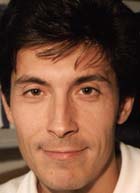Maurizio Corbetta, M.D., has been named the Norman J. Stupp Professor of Neurology.
The announcement was made by David M. Holtzman, M.D., the Andrew B. and Gretchen P. Jones Professor and head of the Department of Neurology.
Corbetta, who is a professor of anatomy and neurobiology and of radiology, is a leader in research into new techniques for rehabilitating the brain after strokes and other injuries.

He also is head of the Stroke and Brain Injury Rehabilitation section in the Department of Neurology and clinical director of these programs at the Rehabilitation Institute of St. Louis.
“Stroke is a major cause of motor and cognitive disability and dementia in the elderly,” Holtzman said. “Dr. Corbetta’s ultimate goal of understanding how to improve brain recovery in this setting makes him and his research an excellent fit for the Stupp chair.”
Corbetta will succeed Eugene M. Johnson, Ph.D., as the Stupp professor. Johnson, who will continue as a professor of neurology and of molecular biology and pharmacology, voluntarily relinquished the chair so it could be used to support an outstanding younger faculty member.
Much of Corbetta’s research employs advanced brain imaging technology to assess brain activity changes over time during recovery from injury.
“We study cognitive functions of the normal human brain and the recovery of these functions in elderly patients with brain injuries,” Corbetta said.
“We are applying ideas and concepts from studies in normal subjects to understand how the brain adjusts to and compensates for injury.
We believe these studies provide critical information for mapping out the natural course of recovery.”
Corbetta hopes to associate certain patterns of brain changes with improved prospects for a better recovery. He and his colleagues can then use this information for prognosis and to develop therapies that promote optimal brain recovery.
At a more basic level of research, Corbetta is a leader in study of the brain mechanisms that allow people to attend to important information — objects, people or sounds, for example.
In the early 1990s, he collaborated with Steven E. Petersen, Ph.D., the James S. McDonnell Professor of Cognitive Neuroscience in Neurology, to pioneer the first studies of visual attention in the human brain using brain imaging techniques.
More recently, Corbetta collaborated with Gordon Shulman, Ph.D., research scientist in neurology, to develop a novel anatomical model of how different systems in the brain control voluntary and stimulus-driven attention.
Corbetta likes to use classical paintings to illustrate this idea.
“When you look at the Mona Lisa, for example, the face of the woman who is pictured is large and bright, and that will draw your attention involuntarily,” Corbetta said.
“However, based on prior knowledge of her enigmatic expression, many first-time viewers will focus in on her lips, the source of that expression.”
Corbetta has studied the systems in the brain that create these two types of attention and how they interact.
He has begun to test this anatomical model in patients whose ability to orient on a stimulus has been disrupted by stroke damage.
“At any given moment, what we pay attention to and where and how we pay attention to it reflects a balance between internal goals and expectations and external stimuli that automatically attract our interest,” Corbetta said.
Johnson became the first Stupp Professor when the chair was created in 1994 through a gift from the Norman J. Stupp Foundation, which supports medical research and education programs.
The Stupp foundation was established in 1952 by Norman Jacob Stupp and his wife, Marie. Norman, who died in 1979, graduated from the University in 1921 with a degree in civil engineering.
Johnson, formerly co-director and now associate director of the Alzheimer’s Disease Research Center, became the first Stupp professor because of his pioneering work with factors in nerve cells that can lead them to self-destruct.
“I am extremely grateful to Dr. Johnson for his generous decision to relinquish his named professorship while he still is a very active investigator,” Coretta said.
“This is a great example of why Washington University is so unique in terms of collaborative research and collegiality.”